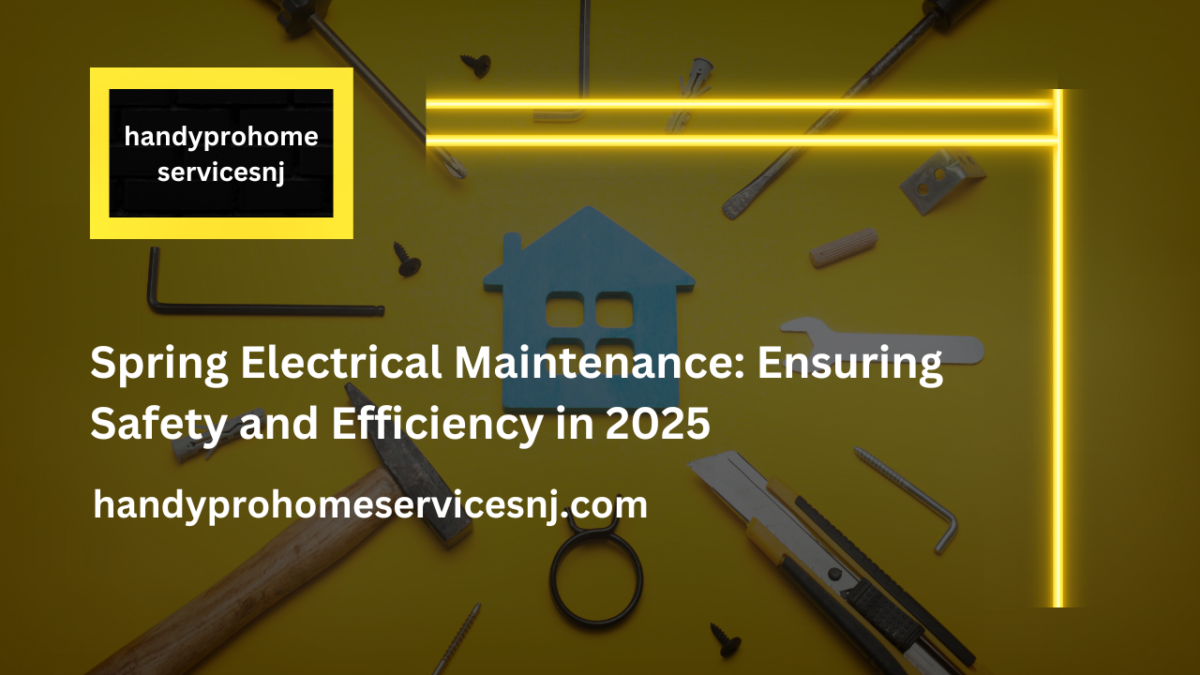Spring Electrical Maintenance: Ensuring Safety and Efficiency in 2025

Spring into Action: Essential Home Repairs to Tackle This Season
April 30, 2025Key Takeaways
- Regular spring electrical maintenance prevents hazards and can save NJ homeowners thousands through energy efficiency upgrades and available tax incentives
- Basic DIY inspections of outlets, switches, and breaker panels should be complemented by professional electrical service evaluations
- The Inflation Reduction Act provides substantial rebates and tax credits for energy-efficient electrical upgrades in 2025
- Smart home technology integration can reduce energy usage by up to 19% while improving safety monitoring capabilities
- Local electrical services in New Jersey can help homeowners navigate compliance requirements and maximize seasonal maintenance benefits
Spring brings renewal, and in 2025, there’s never been a better time to renew your home’s electrical systems. As you plan your seasonal home maintenance, your electrical system deserves special attention—not just for safety, but for substantial financial benefits waiting to be unlocked.
Think about it: when was the last time you really examined your home’s electrical infrastructure? For most New Jersey homeowners, the answer is “not recently enough.” Yet your electrical system silently powers every aspect of modern life, and its proper maintenance directly impacts your family’s safety, your monthly expenses, and even your property value.
With Americans saving an impressive $8.4 billion through clean energy and efficiency tax credits in 2023 alone, according to Financial Times, the financial case for electrical maintenance has never been stronger. Let’s explore how you can make spring electrical maintenance work for your home, safety, and wallet in 2025.
The Overlooked Dangers of Neglecting Electrical Maintenance
Everyday Hazards in the Home
Your home’s electrical system ages just like everything else. Over time, wiring deteriorates, connections loosen, and once-adequate systems become overwhelmed by modern demands. These everyday hazards can lurk behind walls and inside outlets, silently waiting to cause problems.
The risks are far from theoretical. Electrical injuries affect more than 30,000 people annually in the United States, resulting in approximately 1,000 deaths, according to MedlinePlus Medical Encyclopedia. Behind each statistic is a family whose lives changed in an instant, often from problems that proper maintenance could have prevented.
Common household electrical hazards include:
- Outdated wiring systems unable to handle modern power demands
- Overloaded circuits from too many high-powered devices
- Damaged outlets and switches with exposed wiring or loose connections
- Improperly grounded systems that create shock risks
- Moisture intrusion in electrical components, particularly after winter
What makes these hazards particularly concerning is how easily they go unnoticed until they cause significant problems. That intermittent flickering light might seem like a minor annoyance, but it could signal loose wiring that’s creating excess heat—a primary cause of electrical fires.
Seasonal Factors: Why Spring is the Best Time
Why is spring the ideal season for electrical maintenance? Winter’s harsh conditions can be particularly tough on electrical systems. Freezing and thawing cycles may have impacted outdoor electrical components, while increased indoor heating usage puts additional strain on circuits.
As spring arrives, your electrical usage patterns change dramatically. Air conditioning units come online, outdoor power tools return to regular use, and many homeowners begin using more outdoor lighting. This seasonal transition creates the perfect opportunity to identify and address potential problems before they escalate during summer’s peak electricity consumption.
Spring is also ideal for electrical maintenance because:
- Milder weather makes it easier to access outdoor electrical components
- Natural light allows for better visibility during inspections
- You can address issues before summer’s high-demand cooling season
- Contractors typically have more availability than during emergency-heavy summer months
For a comprehensive approach to seasonal home upkeep, check out our guide to Spring into Action: Essential Home Repairs to Tackle This Season for additional maintenance priorities beyond electrical systems.
Essential Spring Electrical Maintenance Tips for Homeowners
Inspecting and Testing Core Electrical Systems
Start your spring electrical maintenance with a methodical inspection of your home’s critical electrical components. While some tasks are suitable for DIY, remember that safety should always come first.
What can I inspect myself?
Create this simple checklist for your DIY electrical inspection:
| Component | What to Check | Red Flags |
|---|---|---|
| Outlets | Physical damage, looseness, proper function | Discoloration, warmth to touch, sparking |
| Switches | Proper operation, strange sounds, physical condition | Buzzing, flickering, excessive heat |
| GFCI Outlets | Test monthly using the “Test” button | Failure to trip, reset difficulties |
| Visible Wiring | Condition of insulation, proper securing | Fraying, cracking, exposed wire |
| Electrical Panel | Clear access, proper labeling, no corrosion | Rust, buzzing sounds, warm spots |
For a comprehensive inspection, use all your senses. Strange smells (especially burning odors), unusual sounds, or visual anomalies all warrant immediate attention from a professional.
While DIY inspections are valuable, recognize their limitations. The most dangerous electrical problems often hide behind walls or in complex system components. That’s why professional inspections remain essential, particularly if your home is over 15 years old or you’ve experienced any warning signs.
Regular Upkeep: Smoke Detectors, Carbon Monoxide Alarms, and Outdoor Lighting
Beyond your core electrical system, several safety-critical devices deserve special attention during your spring maintenance:
- Test all smoke detectors – Replace batteries and test function using the test button. Remember that smoke detectors generally need complete replacement every 10 years.
- Check carbon monoxide detectors – Like smoke detectors, these life-saving devices need regular battery changes and testing.
- Inspect outdoor lighting and outlets – Winter weather can damage outdoor electrical components. Check for water intrusion, damaged covers, and proper function.
- Test landscape lighting and sprinkler systems – Examine transformers, connections, and timers for damage or improper settings.
- Clean ceiling fans and lighting fixtures – Dust buildup not only reduces efficiency but can create fire hazards when in contact with hot bulbs.
This regular upkeep doesn’t just improve safety—it extends the lifespan of these systems and improves their efficiency, saving you money and hassle over time.
Signs You Need Professional Electrical Services NJ
While DIY inspections are valuable, certain warning signs indicate you need professional help immediately:
- Frequently tripping circuit breakers – This indicates overloaded circuits or more serious wiring issues
- Flickering or dimming lights – Points to loose connections or capacity problems
- Warm or discolored outlets or switches – Suggests dangerous heat buildup
- Buzzing, sizzling, or crackling sounds – Indicates active electrical problems
- Burning smell near outlets or panels – Potentially serious fire risk requiring immediate attention
If you’re experiencing any of these issues, or you’ve noticed multiple minor problems, it’s time to contact a licensed electrician. For more comprehensive information on electrical warning signs, visit our detailed guide on What Are the Warning Signs of Faulty Electrical Wiring?
The Financial Benefits of Energy-Efficient Upgrades and Maintenance
Harnessing Incentives: Rebates and Tax Credits
The financial landscape for electrical upgrades in 2025 offers unprecedented opportunities for homeowners. The Inflation Reduction Act includes $9 billion in home energy rebate programs and 10 years of consumer tax credits for energy-efficient technologies, according to recent analysis.
For New Jersey homeowners specifically, these federal incentives combine with state-level programs to create substantial savings opportunities. Here’s what you need to know:
- Federal Tax Credits – Up to 30% of costs for qualifying electrical upgrades and renewable energy systems
- Point-of-Sale Rebates – Immediate discounts on energy-efficient appliances and systems
- Performance Incentives – Additional savings based on demonstrated energy reductions
These incentives make 2025 the ideal year to consider more substantial electrical upgrades like panel replacements, whole-house surge protection, or smart electrical management systems. What might have seemed financially out of reach in previous years now offers an attractive return on investment.
Energy Efficiency in Action: Stats and Strategies
The numbers speak for themselves: The Energy Star program has saved over 5 trillion kilowatt-hours of electricity and more than $500 billion in energy costs since its inception, according to Energy Star data. These aren’t just abstract figures—they represent real savings opportunities for homeowners who prioritize energy efficiency.
Even more impressive, deep energy retrofits can achieve energy savings of 30% or more while significantly improving building value, as reported by the Rocky Mountain Institute. For the average New Jersey homeowner, this translates to hundreds or even thousands of dollars in annual utility savings.
Practical strategies to capture these benefits include:
- Upgrading to LED lighting throughout your home – A simple change that reduces lighting energy use by up to 75%
- Installing smart power strips and energy monitors – Eliminates phantom power draw from electronics
- Upgrading to Energy Star appliances – Particularly impactful for refrigerators, washing machines, and HVAC components
- Adding programmable or smart thermostats – Can reduce heating and cooling costs by 10-15% annually
- Improving insulation and sealing – Reduces load on electrical systems, especially for heating and cooling
Many New Jersey utilities also offer specific programs that provide rebates, free assessments, or direct installation services for energy-efficient upgrades. Check with your local provider about available programs before beginning any electrical projects.
Upgrading for Safety and Smart Energy Efficiency
Modernizing Home Electrical Systems and Appliances
The technology powering our homes has evolved dramatically, yet many New Jersey properties still rely on electrical systems designed for a different era. Modernizing these systems delivers dual benefits: enhanced safety and improved efficiency.
Particularly impactful upgrades include:
- Electrical panel replacement – Modern panels offer better safety features and capacity for today’s demands
- Whole-house surge protection – Protects sensitive electronics from damaging power fluctuations
- Smart circuit breakers – Allow remote monitoring and control while providing enhanced protection
- Arc fault circuit interrupters (AFCIs) – Detect dangerous arcing conditions before they cause fires
- Updated wiring systems – Replace outdated knob-and-tube or aluminum wiring with safer alternatives
The efficiency gains can be substantial. A field demonstration in 2023 showed that predictive heating control systems reduced daily heating energy use by 19% in an all-electric house, according to research by Pergantis et al. Similar gains are possible across multiple systems through strategic upgrades.
Choosing and Installing Energy Star-Certified Products
When upgrading electrical components and appliances, Energy Star certification provides a reliable indicator of efficiency. These products must meet strict guidelines while delivering the performance consumers expect.
Consider these factors when selecting Energy Star products:
- Look beyond the purchase price – Calculate the total cost of ownership including energy savings over time
- Check for compatibility with smart home systems – This enhances convenience and further improves efficiency
- Verify qualification for tax incentives – Not all energy-efficient products qualify for federal or state incentives
- Consider professional installation – Proper installation ensures you actually achieve the rated efficiency gains
For professional guidance on electrical system upgrades, our team at Electrical Services in West Long Branch NJ can help you navigate options and implement solutions tailored to your home’s specific needs.
Leveraging Local Electrical Services NJ for a Hassle-Free Spring
Why Professional Inspections Matter
While DIY electrical checks have their place, professional electrical inspections provide a level of expertise and thoroughness that significantly enhances safety and performance. Licensed electricians bring specialized tools, extensive training, and experienced eyes to electrical evaluations.
Professional electrical inspections typically include:
- Comprehensive panel inspection and thermal imaging to detect hotspots
- Load calculations to ensure your system meets current demands
- Code compliance evaluation to identify safety issues
- Detailed assessment of grounding and bonding systems
- Evaluation of wiring condition, including areas not visible to homeowners
- Testing of protection systems like GFCIs and AFCIs under load conditions
The value extends beyond identifying existing problems. Professionals can help prioritize repairs and upgrades based on safety concerns, efficiency gains, and budget considerations—creating a roadmap for ongoing electrical improvement.
Handy Pro Home Services NJ: Partnering for Ongoing Safety and Efficiency
For New Jersey homeowners seeking comprehensive electrical maintenance, Handy Pro Home Services NJ offers specialized electrical services tailored to the unique needs of local properties. Our approach combines thorough inspections with practical recommendations and skilled implementation.
Our electrical services include:
- Seasonal electrical maintenance programs
- Energy efficiency assessments and upgrades
- Code compliance updates and safety improvements
- Smart home electrical integration
- Emergency electrical repairs and system restoration
Working with licensed professionals ensures all work meets current National Electrical Code requirements—a critical consideration for both safety and insurance purposes. When electrical systems are properly maintained and updated by qualified professionals, you gain peace of mind along with improved performance.
Innovative Technologies and Education for Continued Savings
Smart Home Tech for Monitoring and Energy Management
The smart home revolution has transformed how we interact with and manage our electrical systems. These technologies don’t just add convenience—they create new opportunities for safety monitoring and energy optimization.
Key smart electrical technologies to consider include:
- Smart electrical panels – Provide circuit-level monitoring and control
- Energy monitoring systems – Track usage patterns and identify efficiency opportunities
- Automated load management – Shifts electrical usage to off-peak hours
- Smart outlet integration – Controls individual devices for optimized use
- Predictive maintenance systems – Identify potential failures before they occur
These technologies create a virtuous cycle of improvement: the more data you collect about your electrical usage, the more opportunities you’ll discover to improve efficiency and safety. Many systems also provide remote monitoring capabilities, allowing you to check your home’s electrical status while away.
Making Homeowners Energy Wise: The Power of Electrical Education
Knowledge truly is power when it comes to electrical efficiency. Educational initiatives like the Alliance to Save Energy’s EmPowered Schools program have led participating schools to achieve 5-15% energy savings on their energy bills, according to Alliance to Save Energy data. Similar results are possible in residential settings when homeowners understand how their electrical systems work.
Resources for ongoing electrical education include:
- Utility company workshops and online resources
- Home improvement store classes on electrical basics
- Energy auditor consultations for personalized guidance
- Professional electrician explanations during service calls
- Online communities dedicated to energy efficiency
This education pays dividends beyond saving money. Understanding your electrical system improves safety, helps you communicate more effectively with professionals, and empowers you to make informed decisions about upgrades and maintenance.
Long-Term Outlook: Building Value & Security Through Consistent Maintenance
The Cumulative Effect of Regular Electrical Maintenance
Electrical maintenance isn’t a one-time event but an ongoing process that yields compounding benefits. Each inspection, repair, and upgrade builds on previous work to create increasingly safe, efficient, and valuable electrical systems.
The cumulative benefits include:
- Enhanced property value – Updated electrical systems are major selling points in real estate
- Reduced insurance risks – Many insurers offer discounts for electrical upgrades and regular maintenance
- Lower lifetime costs – Preventive maintenance extends system lifespan and prevents costly emergency repairs
- Improved energy efficiency – Each efficiency improvement reduces costs for the life of the equipment
- Greater peace of mind – Knowing your electrical system is well-maintained reduces stress and worry
This compounding effect makes consistent maintenance one of the best investments you can make in your property. Each spring’s electrical review builds on previous work, creating a safer, more efficient home year after year.
Planning Ahead: Scheduling and Record-Keeping
Creating a structured approach to electrical maintenance ensures nothing falls through the cracks. Consider developing:
- Annual maintenance calendar with seasonal tasks clearly defined
- Digital or physical folder for electrical system documentation
- Maintenance log tracking all inspections, repairs, and upgrades
- Equipment inventory with installation dates and warranty information
- Budget planning tools for future electrical improvements
This organization not only improves your maintenance effectiveness but also creates valuable documentation for insurance purposes and future home sales. Detailed records of electrical improvements can substantiate higher property values and demonstrate your commitment to proper home maintenance.
Ensuring Your Home’s Electrical Future
As we’ve explored throughout this guide, spring electrical maintenance delivers substantial benefits for safety, efficiency, and financial well-being. The unique opportunities available in 2025—from unprecedented tax incentives to revolutionary smart technologies—make this the perfect time to prioritize your home’s electrical systems.
Remember that electrical maintenance combines both DIY vigilance and professional expertise. While regular visual inspections and basic testing fall within most homeowners’ capabilities, partnering with qualified electrical professionals ensures your system meets current standards and operates at peak performance.
Ready to transform your home’s electrical safety and efficiency this spring? Contact our team at Handy Pro Home Services NJ to schedule a comprehensive electrical inspection and discuss how we can help you capture the full benefits of proper electrical maintenance. Your home—and your wallet—will thank you.
FAQs
What are the most important electrical components to check during spring maintenance?
Focus on five critical areas: your electrical panel (check for corrosion, proper labeling, and clear access), GFCI outlets (test monthly using the test button), outdoor electrical components (inspect for winter damage), smoke and carbon monoxide detectors (test and replace batteries), and any areas where you’ve noticed intermittent issues like flickering lights or warm outlets. These components have the greatest impact on safety and are most likely to show seasonal wear.
How can I tell if my home needs an electrical panel upgrade?
Common signs include frequent circuit breaker trips, reliance on power strips and extension cords, flickering lights when major appliances run, having a fuse box instead of circuit breakers, or a panel manufactured by Federal Pacific Electric, Zinsco, or Challenger (known problematic brands). Also consider upgrading if your home is over 20 years old, you’re adding major appliances, or if your panel is rated below 100 amps, which is inadequate for modern homes.
What electrical upgrades offer the best return on investment in 2025?
With current federal incentives, the highest ROI typically comes from whole-house surge protection systems, smart panel upgrades, LED lighting conversions, and smart thermostats. These upgrades offer the perfect balance of upfront affordability, substantial energy savings, and eligibility for tax credits or rebates. Specific returns vary by home, but many homeowners recoup costs within 2-5 years through energy savings alone, not counting potential tax benefits.
Are there specific electrical concerns for older homes in New Jersey?
Absolutely. Many older New Jersey homes have knob-and-tube wiring, insufficient grounding systems, aluminum wiring, or outdated 60-amp service—all significant safety concerns. These homes often have ungrounded outlets, insufficient kitchen and bathroom circuits, and inadequate outdoor electrical protection. Professional inspection is particularly important for homes built before 1980 to identify these hidden hazards and bring systems up to current New Jersey electrical code requirements.
How do smart home technologies improve electrical safety and efficiency?
Smart electrical systems improve safety through continuous monitoring that can detect abnormal patterns (like ground faults or overheating circuits) before they become dangerous. On the efficiency side, these systems optimize energy use by automatically turning off idle devices, shifting usage to off-peak hours, and providing detailed usage data that helps identify energy waste. Some systems can reduce overall electricity consumption by 10-20% while simultaneously enhancing safety monitoring capabilities.




